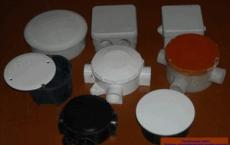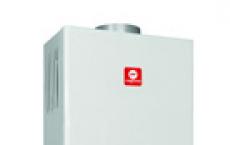For whose account and who should change the risers in the apartment building.
How is it done by own hands to replace the risers in an apartment building? We will consider the main points of this rather complex work and the problems that can be encountered at its various stages: from resetting the risers to their launching.
Material selection
When building and overhauling apartment buildings, the risers.
How justified is this choice of material?
- The installation itself is simplified many times. It is performed without welding in the shortest possible time.
- Pipes are easily bent by hand: you can make a bypass or bend in place.
- Pipes and fittings are easy: lifting the necessary materials to the fifth floor does not take much energy from you.
It would seem that everything speaks in favor of modern materials. It was not there.
Attention: if you want to create a minimum of problems in the future, use only and exclusively galvanized water and gas pipes to mount risers and piping to the valves.
Why? After all, the regular operating mode of the heating system with a margin is within the parameters stated for the same polypropylene?
You see, nobody canceled the human factor. It is necessary for the locksmith to forget to close the inlet latches during the heat pipeline tests for density - and the pressure in the risers will be equal to not 4-5 atmospheres, but 10-12.
It is enough to open the gate valves at the start of heating quickly - and the result will be a hydraulic shock, at which a short-term pressure jump is possible, and at all up to 15-20 kgf / cm2.
And the annual temperature test? Remember those few days in the spring when the batteries are hot? Work in the limiting mode reduces the life of plastics, and very much.

In the photo - very doubtful implementation of the replacement of the riser section. Placing plastic in a centralized heating system before the shut-off valves is not a good idea.
So, the choice is made. To replace the risers we need a galvanized pipe DN20; We will also make the connections to the heating devices. What will be required besides a few meters of the pipe?
The answer depends on whether you have welding and related skills at your disposal. Consider: you need to be able to make sealed seams, and with a mirror.
By the way, gas welding in problematic conditions is somewhat easier.
- If there is welding, we need welders - long and short threads, to which radiators and valves will join.
In addition, you will need three locknuts per radiator; three shots - one for podvodki and a jumper; three valves DN20.
The valves will in different positions either block the water flow through the jumper, directing the entire volume of water into the heater; or, conversely, limit the patency of the battery with a fully open jumper.
Useful: valves - only and exclusively modern ball. It is better to completely forget about the existence of screw valves.
Alternatively, a choke or a thermal head can be installed on one of the sub-assemblies.
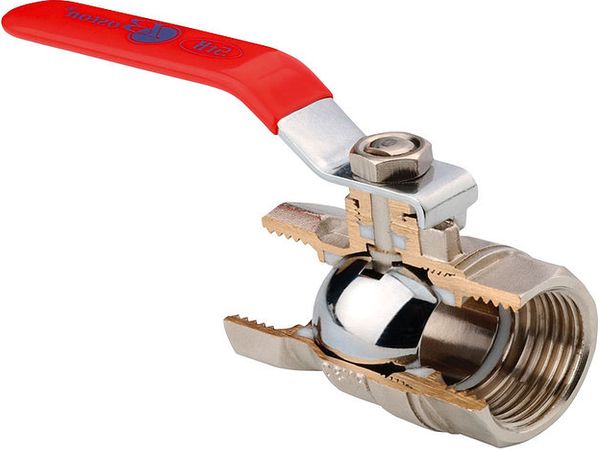
- When assembling manually, you have to arm with a die with a holder and a turbine with a cutting circle over the steel. All straight sections of threaded pipes will be made in place.
In addition, all of the above set of parts will be needed; two tees (cast iron or brass) and two couplings. To cut a carving, of course, it is necessary in a vice.
Getting Started
Resetting the riser
How to disconnect the heating pipe?
In houses with bottled bottles, the risers are connected in pairs. You will have to find out exactly what kind of riser you are interested in. The simplest way to do this is to climb into the apartment on the top floor and look at the location of the jumper.
Upper bottling means that you have to close one valve in the basement and in the attic.
How to find the right valve? Orient on the entrances - in the basement stairways are always visible. After the right entrance is found, it is not difficult to calculate the position of the valve you need.
Both valves overlap; then the plugs are opened or the relief tabs open. Wait for the water to come off to make sure that the shut-off valve is fully functional. It is done.
![]()
If instead of the plugs there are reset valves - and reset, and starting will be easier.
Important: the switch-off of the riser in the heating season is only permissible if you have access to the upper apartment. If it is non-residential - you simply can not start the heating by bleeding the air.
Dismantling of the old riser
The easiest way to disconnect the heating devices is to cut the piping to them by the turbine. Then the locknuts are given, after which the wire ends are twisted from the radiator plug.
Where to cut the riser itself?
The choice of location is affected by two factors:
- Your relations with neighbors from below and from above. Heating spans have a sense to change through the overlap: as experience shows, the corrosion most quickly destroys the pipe precisely inside the concrete.
- Convenience of further work. Cut the pipe in the place where you can cut the thread on it or weld the finished one. Preferably - not too close to the floor and wall.

Thread cutting
An experienced welder, I think, there is no need to prompt the order of actions; but thread cutting manually may well be unusual for the reader.
What should I look for?
- A chamfer is removed from the pipe by means of a file or a turbine - a cut is made for the die.
- The holder with a die is put on the pipe with a long side. This is necessary to ensure that the die enters the pipe strictly perpendicular to its axis.
- On the stand are cut short threads - no more than five threads.
- When the die comes to the edge of the pipe, it is necessary to press the holder with the maximum effort available to you.
- The riser itself, after the first thread is cut, must adhere to the gas key. The force is applied in such a direction to compensate the torque from the die. Otherwise, the situation is quite real when you tear off the thread from the radiator above or below the riser.
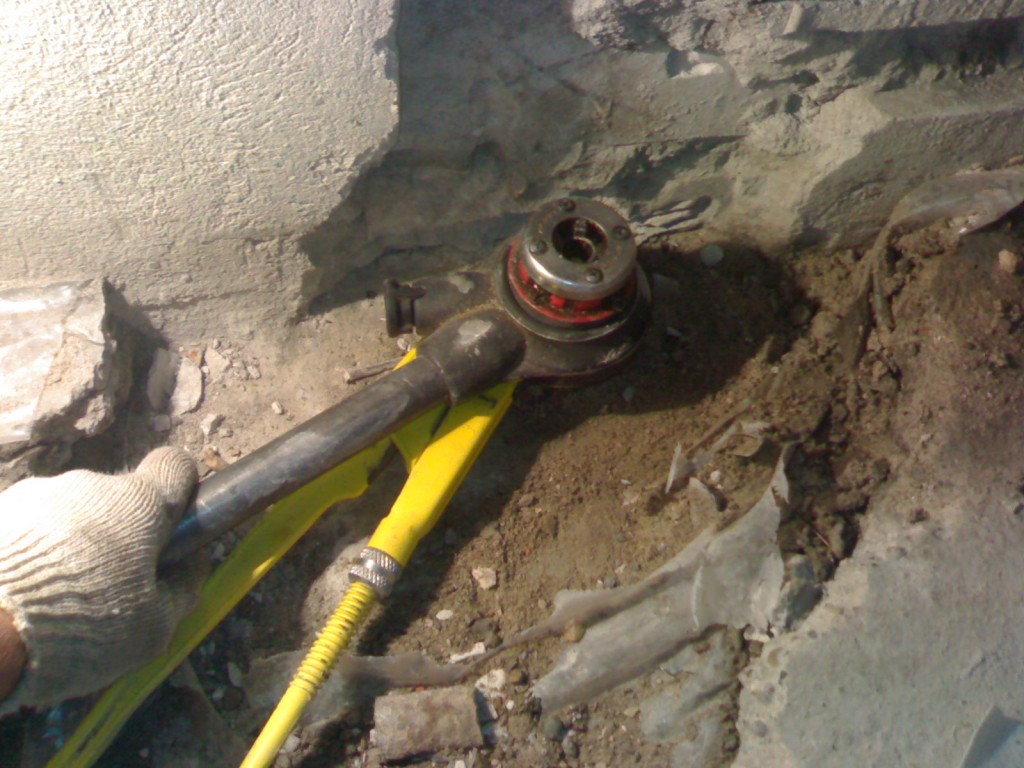
Nuance: the exception is the convector installed for welding. Welded to the convector pipe you will not tear off; The riser is not necessary when threading.
Long threads are cut on the pods to the radiator (on them it is necessary to drive off the radiator plugs and locknuts) and on the run in the jumper. When cutting, the length of the tube is fixed in the vice - so that the threads that have already been cut are not jammed or deformed.
Assembly
Cut-in-place pipes with cuts on both sides of the short threads are passed through the floors and the couplings are connected to threads on the riser. Winding - plumbing linen with paint or silicone sealant; excellent results and gives a polymer thread (for example, Tangit Unilok).
In the second case, the price of the winding is much higher; but for a one-time job, you can ruin your packaging.

Then on the threads are twisted tees. The distance between the internal threads, oriented towards the heater, should be exactly 50 centimeters on their axes: otherwise it will be necessary to mount the liner in the hood.
In addition to the fact that it is difficult to seal the locknuts when the counternut is twisted, the inclined eyeliner looks simply sloppy.
The following are screwed into the valve tees - with threads of the papa-mom or mom-mama with short branch pipes.
Long shut-offs are screwed into the shut-off radiator of the valve - branches with a short thread on one end and a long one on the other. They can immediately be driven to the limit stop nut (flat side to the radiator) and a radiator cap.
The bridge is mounted in the same way as any other drive: the long thread is screwed into the tee with the locknut screwed up to the stop; then a short thread, combined with the thread of the valve, is wound up and screwed into it, while the long thread is turned out of the tee by a short length; then the lock nut is tightened and clamped.
The radiator is connected last. It is hung on the brackets so that the threads of threads under the plugs coincide with the axes of the leaks. Then pre-wound plugs are driven into it; after them the operation is repeated with locknuts.
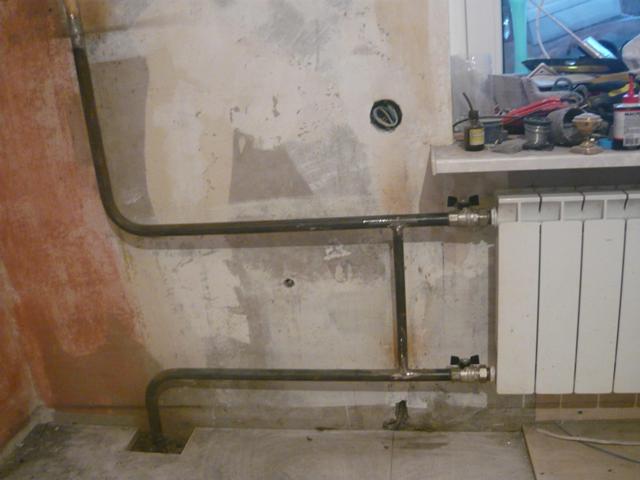
If you have welding at your disposal - you can do with the minimum number of threads.
Running the riser
Replacement of the riser in the apartment we have, in general, completed. There remained a mere trifle: test the assembled structure under pressure and run the riser, resuming the circulation in it.
Let's start with the tests.
At this stage, it is desirable to have an assistant who can inform you about this by a mobile phone or in the simplest way by tapping on the riser.
- Open the valve on the jumper and block both valves leading to the radiator. So we will limit the number of threads under pressure during trial run.
- Screw in the plugs or close the reliefs in the basement.
- Open the valve on the replaced riser.
Important: if screw valves are installed on the risers, the valve that is set by the arrow in the direction from the filling to the apartments opens. The instruction is related to the device of this type of shut-off valve: by opening the opposite valve, you are more likely to tear the valve from the stem.
- As soon as the water is noisy in the slightly open valve, the pressure in the risers and bottling can be considered equal. Both valves on the twin risers (in case of top bottling - in the basement and in the attic) open completely.
- Then - a visual inspection: after returning to the apartment, we open the valve on the pipeline (too slowly, giving the radiator to fill with water without a hydraulic shock) and carefully review all the threads for leaks.
Now it remains only to bleed the air, resuming circulation.
How to do it?
- In houses with bottled bottles in the apartment on the top floor a Maevsky crane opens on the bridge between the risers. When the tap goes water - do not rush to leave: air bubbles may linger in the radiators and be near the air vent with some delay.
Definitely about the renewed circulation speaks only the heating of the riser.
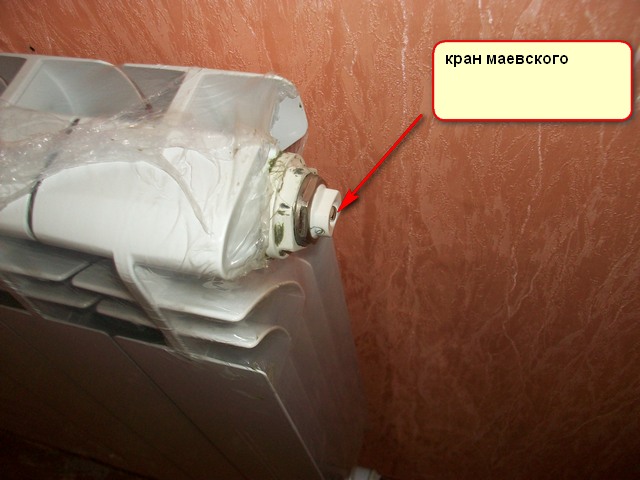
The air vent can stand in the crossbar under the ceiling, and in the radiator. The main thing - that above it there were no pockets for air.
- The top filling does not require you to do anything active: the air plug will be forced into the expansion tank in the attic.
However, if its volume is small - it is better not to be too lazy and slightly open the vent at the top of the tank.
A special case
What can be done if, for some reason (no occupants of the upper floor, etc.), the air does not blow out?
Not always, but in most cases, you can resume circulation by overtaking the riser to a reset. Experienced locksmiths often do this with stubs; much simpler, more convenient and safer, however, when they are installed in place of their reliefs - ball or screw valves.
The algorithm of action is simple: on one riser the valve is opened, on the second - the relief valve. At the front of the water, most of the air is taken out. If the circulation does not resume, you can repeat the riser distillation in the opposite direction.
The method always turns out to be effective in the case if in quality. Aluminum and bimetal radiators due to narrow internal channels, too, are usually passed without problems; but often delayed by air congestion.

Conclusion
Want to know more about replacing risers? You are waiting for a video at the end of the article. Video lessons are often more informative than the most detailed narrative in writing. Good luck in repair!
Not all residents of the Russian Federation live in new homes, therefore problem of wear and tear on communicationsit is familiar to many.
The sewage pipes, damage and rupture of which can lead to flooding and property damage, are no exception.
About the procedure replacement of riser in the apartment we will talk in this article.
Dear readers! Our articles tell us about typical ways of solving legal issues, but each case has a unique character.
If you want to know, how to solve your problem - contact the online consultant form on the right or call by phone free consultation:
What are the norms of the temperature in the apartment during the heating season for SanPin? Learn about this from ours.
general information

In old houses, sewer pipes and pipes in the bathrooms are made of cast iron - reliable but not the most durablematerial.
Sooner or later such pipes begin to fail, after which there is a danger of leakage, splitting of the pipe, damage to property and liability.
In order to prevent the sad consequences, the riser and sewage branches should be replaced. In such situation often the owners do their own thing and change the riser in the apartment by yourself.
Not everyone knows that you can replace the sewer and other risers at the expense of the management company.
Regulations
Replacement and repair of sewer, water pipes and heating pipes are regulated by:
- rules for the maintenance of common property in the MKD;
- rules and norms of technical exploitation of housing stock;
- the methodical grant on the maintenance and repair of available housing MDK 2-04.2004.
Private or cottage property?

According to the rules, the obligation to maintain and repair communications lies on the owners.
Water pipes that are branches from riser pipes are kept, repaired and changed by the owners independently and at their own expense.
Pipe-risers, which are used by several apartments, are common propertyaccording to the rules for the maintenance of common property in the MKD.
To the common property are also branches from the riser to the first docking connection.
Who should change?
Replacement of sewer and water risers is made by Housing and Communal Services, HOA or other companies. The decision to repair is taken by the management company at the request of homeowners.
What are the rules for the use of living quarters and common property in apartment buildings? you will find on our website.
At whose expense?

By law, the owners of housing are responsible for the contenthouse property.
If the sewer stand fails and needs to be repaired or replaced, then it must be paid from the funds contributed by the owners to pay for these works.
Owners of housing pays these expenses in their own under the article "maintenance and repair of housing."
If a capital replacement is made risers on all floors, then the funds can be taken at the expense of payments to.
A completely different situation develops when the owner wants to replace the serviceable riser for any personal reasons, for example, when the bathroom is redeveloped.
In this case, all costs for replacement of the riser are borne by the owner, work is also carried out independently.
Replacement of risers in municipal housing is done at the expense of the landlord, that is, the municipal authorities.
In this case, replacement is free of charge at the request of the employer to the municipal bodies responsible for the city's housing and communal services.
How to change?

To replace a failed or in need of a replacement riser should contact the management company with a statement in the name of her chapter.
Before you write a statement in the Criminal Code, you can call a plumber on the house, which will constitute an inspection report of the sewer pipe, fix the damage and need to replace the riser.
At the end of the application, you should write a specific request for replacement or repair of the sewer pipe. Then put the date and signature of the owner. The application is made in two copies, one of which remains with the owner, the other is given to the Criminal Code.
Applications for replacing the riser pipe.
The owner of the dwelling who submits the application must be a bona fide payer of communal payments, so that his application was adopted and considered.
After consideration of the application with the owner, a convenient time for the work is agreed upon. Replacement of the riser is made by employees of the management company or contractors involved in the Criminal Code.
The owner must provide easy access to the bathroom, in order for the pipes to be replaced. How much does it cost to replace the riser in the apartment?

Additional funds When replacing the riser or branches from it to the first docking connection, the owner does not have to pay.
The approximate cost, which will cost replacement of the riser in one apartment - from 4 to 7 thousand rubles.
Quite often, homeowners are faced with the fact that they need to pay for the replacement of the riser, arguing that the riser pipes are in the owner's room and for them the owner of housing is responsible.
In such cases, it should be reminded to the employees of the Criminal Code that the sewage, water risers and battery stands that serve more than one apartment are common property, and the MC is responsible for their replacement and repair.
Moreover, the replacement of risers in any case will be paid by the owners of housing out of funds, paid by them in communal payments.
About what to do, if someone from the tenants of the house against the replacement of the common riser, you can learn from the video:
Newly-owned apartment owner sometimes does not even suspect how many problems he will now have to deal with. And one of them, who now owns the duties to replace the risers in a privatized apartment? After all, together with the residential area, communications, including general-purpose houses, also become property.
Replacement of pipes
All those communications that are located inside the apartment and which only its owner and tenants can use, questions about their belonging do not cause. This is private property. And the owner can do with them whatever he thinks fit. Of course, if this does not lead to the fact that the property of its neighbors or their other rights and interests will suffer.
The owner of the apartment has the right:
- replace old metal pipes with more modern ones;
- to put new mixers, counters;
- increase or decrease the number of plumbing;
- change batteries, etc.
All this he does at his own free will and at his own expense. This does not cause surprise or doubt in the legitimacy of such actions. The right to property includes the possibility of such changes and improvements.
But when it comes to replacing the risers, that is, those thick pipes that connect all the floors and apartments into a single whole, opinions diverge.
Tenants believe that the management company is responsible for the common property, but in that they say that since this is the common property of the apartment owners, it is their responsibility to replace or repair the pipes. Let's try to figure out who's right.
Who should change the risers in a privatized apartment?
It is worth remembering that in addition to the right to property there is also the so-called burden of the owner, which consists in the need to maintain their property in good condition and pay for its maintenance.
Including:
- water;
- sewage;
- other benefits of civilization.
And here the question arises: who owns those pipes and their branches that are no longer inside each private apartment, but connect it with engineering communications that bring water, warmth and light to the building itself?
They, as it turns out, belong to the common property belonging to all owners. That is, those pipes that are private in the apartment, and the pipes are common.
Legislation
Legislation confirms this. The Government in 2006 approved the Rules concerning the maintenance of common property.
They list what exactly relates to property that is recognized as common:
- Equipment serving more than one apartment.
- The system of water disposal (i.e., sewerage), etc.
But the confirmation of the fact that all pipes, including water pipes, heating, gas and sewer are the property of the tenants of the house, does not answer the question, who still has to change the risers in the privatized apartment? The same document refers to such a concept as repair (current and capital).
The definition of the current repair, given in the Rules for the technical operation of housing stock, includes such positions with respect to all pipelines within the residential structure, such as:
- installation;
- replacement;
- restoration of efficiency.
Duties of the owner
According to the Rules, the decision-making on the need for ongoing and, all the more important, overhaul is on all owners.
Owners of apartments and common property are obliged:
- to ensure the normal technical condition of common house communications;
- make a decision on their repair in the event of such a need.
But the owners themselves can repair only those equipment that directly services their apartment. Because this is their private property. And for the repair of common property they transfer part of their duties to the management company, which solves all technical problems for them.
This contract is free of charge, that is, it means paying a certain amount monthly. Her contribution is also the responsibility of the owner of the apartment. In exchange, he receives technical maintenance of the whole house economy.
Responsibilities of ZhEK
The production of all repair work required to maintain the water supply, sewage, heating and other risers in good technical condition is the responsibility of the Housing and Utilities Service. Or another firm with which a relevant contract was concluded.
The basis for the work will be:
- a plan for their conduct;
- act that indicates that any part of the riser needs repair to prevent an emergency situation;
- occurrence of leakage or other malfunction.
In the housing office it is possible to apply with a statement, which they are obliged to consider and give a motivated answer.
At whose expense
All attempts to force tenants to apply to private offices or to pay additional funds for repairing risers are illegal. Since these works are already done at the expense of homeowners.
Monthly in the notice for payment of utilities you can see the line "maintenance and repair of housing." The amount in it depends on the size of the apartment and the number of residents.
According to the norms of the MDC on 2-04.2004 there are two lists of works that are included in the rent. These include:
- the maintenance of various common property;
- technical and other services for communications;
- emergency work;
- maintenance.
That is, all the work on the replacement, maintenance and repair already included in the already quite a large rent.
Therefore, the housing office should change the sewer in the privatized apartment absolutely free of charge. For him already paid.
An exception is the case when repairs are required as a result of repairs by one of the apartment owners who have been arbitrarily manufactured, or any constructive changes in the common house communications. And if as a result of such interference the neighbors suffered, then they will have to compensate them for the damage.
Frequently asked Questions
Consider the questions that owners of privatized apartments often ask.
Replacement of sewer pipe
Since the risers located outside the apartments and connecting several of them are common property, the management company (HOA, Housing department, housing department, etc.) is in charge of replacement. Due to the money that comes in the composition of the rent for "maintenance and repair of the common property of the house."
Any attempt to force people to pay for these works will additionally be illegal.
When trying to reject the requirement to replace the riser to defend its position, it is worth referring to the regulatory documents:
- rules for maintaining the common property of the apartment building;
- methodical recommendations MDK 2-04.2004.
As proof of the performance of their duties for the timely payment of utility services, a copy of the receipt for payment can be attached to the application for repair work.
Replacement of pipes in privatized housing
Everything depends on where these pipes are located and how many apartments they serve. All pipes that are inside the apartment are changed at the expense of the owner. The work can be done both by specialists of the Criminal Code and other persons, on the basis of a civil law contract.
It refers to:
- pipes of water supply, sewerage, heating;
- counters, mixers and plumbing in single use.
All communal communications are maintained by the management company at the expense of the owners of the apartments. Current repairs include the replacement of pipes in case of poor technical condition.
On the video about the duties of the management company
Replacement of riser hvs / hvs
on welding
Replacement sewer riser
within the apartment
3000 rubles / set.
Organization of a water supply point for HVS, DHW, sewage
without regard to the length of the main line from the riser
Input terminal of the HVAC / DHW input
on welding
Installation of water meters in the kit
with mud filter and pressure reducer
3000 rubles / set.
Installing the aquapark system
In the process of repairing an apartment, sometimes customers have a desire to make redevelopment of residential and non-residential premises. Combine or divide the bathroom and toilet. Very often this leads to the transfer or replacement of the heating riser or risers of hot and cold water. As a rule, such a procedure is done once for the whole period of residence in an apartment, therefore such works are trusted only by professionals.
With such a problem very often encounter when redeveloping premises or when buying an apartment in a new building.
| Photo 1 Replacement of risers | |||
Also, replacing risers of water supply and sewerage in an apartment is very often needed in old houses, because there they are made of cast iron, and as it is known it undergoes corrosion under the influence of humidity and temperature changes and as a result the pipes are leaking. As rust and dirt settle on the inner walls of the pipes, in consequence the flow of the liquid becomes worse and worse.
Advice! Timely replacement of water supply risers will prevent an accident and prolong the work of sanitary ware. Look at the photo of what is inside the pipes of the old risers.
The inside spans more than half the pipe space!
Our work to replace the riser water supply in one of the apartments in Moscow (District Mnevniki)
Our work on replacing the riser of water supply and sewerage in one of the apartments in Pushkino (Moscow region)
Example of work on the transfer of water supply risers in the apartment of Khimki (Moscow region)


